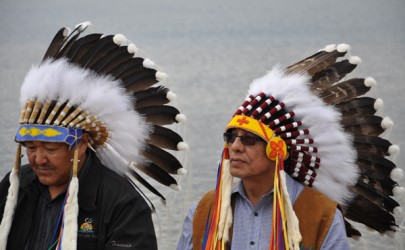Article Origin
Volume
Issue
Year
Lac Brochet was not only the site for the fifth annual Keepers of the Water conference but an actual example of what a community can be when no development takes place.
“We brought people in that area to show them what it looks like before development,” said Vice Chief Don Deranger of the Prince Albert Grand Council, who has been instrumental in coordinating the last three conferences. “What gave me the passion (to be involved) was that water is one of the four elements. We need to protect it for our future generations. We need to protect the water.”
The view flying into Lac Brochet was inspiring, especially for the delegates from eastern Manitoba, said Kevin Carlson, coordinator for this conference.
“They have a lot of hydro development,” he said. “So they were amazed that as they were landing in the community you could actually see the bottom of the lake versus seeing a lot of silt in the water.”
The issues that Aboriginal communities face when it comes to protecting their water differ. While Manitoba faces the challenge of the development of hydro dams and mining, for Saskatchewan, uranium mining is causing concerns, while in Alberta, water is altered by the development of the oil sands.
“If we don’t protect the water we’re not going to have life; but, that doesn’t mean to say that there will be absolutely no development. It just has to be done thoroughly and responsibly,” said Carlson. “Provincial governments tend to think the water stops flowing at their borders.”
But that’s not the way conference attendees think. For them, communication between provinces is the key to keeping water protected from contamination and safe for future generations. That means keeping track of the quantity and quality of the bodies of water across provincial boundaries.
To this end, the Manitoba delegates formed a watershed council in Manitoba “which will go hand in hand with those that have been previously formed in Alberta and Saskatchewan,” said Carlson.
Topics on the conference agenda included working with the Elders and communities from the start of any project and assessing the impact that development will have on the wildlife and the environment.
“Some (provincial crowns) have changed already, like Manitoba Hydro,” said Carlson. “Its plans to develop a new dam works in partnership with the First Nations and the Elders right from the very start of the design of the project. It’s to start working together and developing a united plan.”
“Water is life. Water is a sacred gift,” said Deranger. “Without water nobody can survive.”
The Keepers of the Water website defines the groups as “comprised of First Nations, Métis, and Inuit peoples; environmental groups; concerned citizens; and communities working together for the protection of air, water, and land - and thus, for all living things today and tomorrow in the Arctic Drainage Basin.”
This year’s conference took place Aug. 11-14. The location of next year’s conference has yet to be decided although it may be located in the Yukon or it could return to Saskatchewan.
- 2198 views

